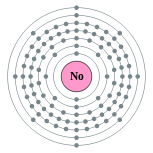Lawrencium
| General properties | |
|---|---|
| Name, symbol, number | lawrencium, Lr, 103 |
| Element category | actinide |
| Group, period, block | n/a, 7, f |
| Standard atomic weight | (262) |
| Electron configuration | [Rn] 7s2 5f14 7p1
2, 8, 18, 32, 32, 8, 3  |
| Discovery | Lawrence Berkeley National Laboratory (1961) |
Lawrencium is a radioactive synthetic chemical element with the symbol Lr (formerly Lw) and atomic number 103. In the periodic table of the elements, it is a period 7 d-block element and the last element of the actinide series. Chemistry experiments have confirmed that lawrencium behaves as the heavier homologue to lutetium and is chemically similar to other actinides.
Lawrencium was first synthesized by the nuclear-physics team led by Albert Ghiorso on February 14, 1961, at the Lawrence Berkeley National Laboratory of the University of California. The first atoms of lawrencium were produced by bombarding a three-milligram target consisting of three isotopes of the element californium with boron-10 and boron-11 nuclei from the Heavy Ion Linear Accelerator. The team suggested the name lawrencium, and the symbol "Lw", but IUPAC changed the symbol to "Lr" in 1963. It was the last element of the actinide series to be produced.
All isotopes of lawrencium are radioactive; its most stable known isotope is lawrencium-262, with a half-life of approximately 3.6 hours. All its isotopes except for lawrencium-260, -261 and -262 decay with a half-life of less than a minute.
Return to Periodic Table




